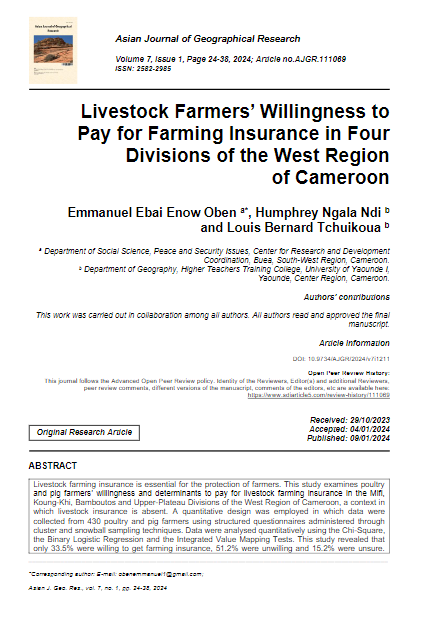Livestock Farmers’ Willingness to Pay for Farming Insurance in Four Divisions of the West Region of Cameroon

Livestock farming insurance is essential for the protection of farmers. This study examines poultry and pig farmers’ willingness and determinants to pay for livestock farming insurance in the Mifi, Koung-Khi, Bamboutos and Upper-Plateau Divisions of the West Region of Cameroon, a context in which livestock insurance is absent. Aquantitative designwas employedin which data were collected from 430 poultry and pig farmers using structured questionnaires administered through cluster and snowball sampling techniques. Data were analysed quantitatively using the Chi-Square, the Binary Logistic Regression and the Integrated Value Mapping Tests. This study revealed that only 33.5% were willing to get farming insurance, 51.2% were unwilling and 15.2% were unsure. More farmers in the Mifi Division were willing to get livestock farming insurance than farmers in other sample divisions. The Chi-Square Test highlighted several variables influencing farmers’ willingness to get farming insurance. Among these variables, the Binary Logistics Regression Test revealed that monthly household income and source of labour were significant determinants of poultry farmers’ willingness to get insurance, while years of experience, monthly household income, total size of the flock and division were significant determinants for pig farmers. Overall, socioeconomic factors influenced pig farmers’ willingness to subscribe to a livestock insurance scheme more than production factors. The Integrated Value Mapping (IVM) combining the predictive effects of both factorswas 35.1%, thus implying that 64.9% variability was not accounted for. For poultry farmers, production factors predicted willingness to subscribe to a livestock insurance scheme more than socioeconomic characteristics. The Integrated Value Mapping (IVM) combining the predictive effects of both components was 51.2%, implying that 48.8% variability was not accounted for. This study recommends that the government set up a National Livestock Insurance Policy and for insurance companies to sensitise farmers on the need and importance of livestock farming insurance.